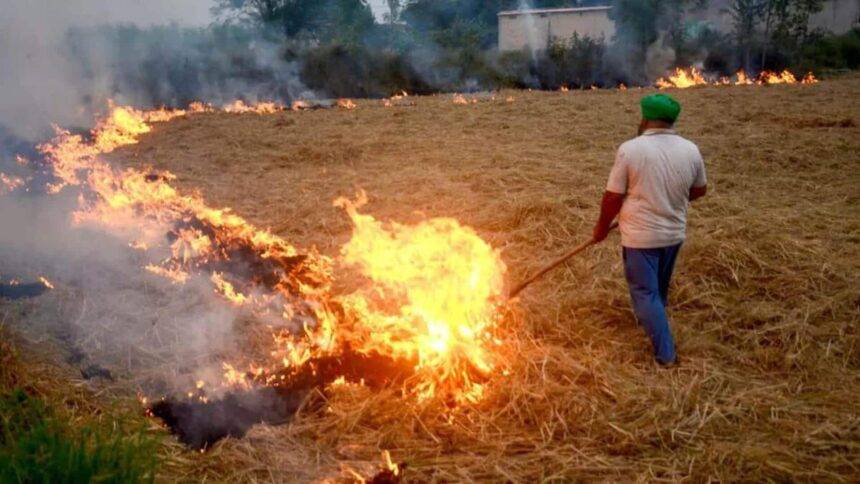Main Points In Hindi (मुख्य बातें – हिंदी में)
इस लेख में निम्नलिखित मुख्य बिंदुओं का उल्लेख किया गया है:
-
प्रदूषण का बढ़ता स्तर: पिछले तीन वर्षों में पराली जलाने में कमी के बावजूद, दिल्ली में प्रदूषण का स्तर रिकॉर्ड ऊंचाई पर पहुंच गया है। विशेष रूप से पीएम 2.5 और एयरोसोल सामग्री के स्तर में वृद्धि देखी गई है।
-
सुप्रीम कोर्ट का आदेश: सुप्रीम कोर्ट ने अधिकारियों को खेतों में आग की निगरानी के लिए स्थिर उपग्रह डेटा का उपयोग करने का निर्देश दिया है। अदालत ने प्रदूषण नियंत्रण उपायों में देरी की आलोचना की और तात्कालिक कार्रवाई पर जोर दिया।
-
प्रदूषण के स्रोतों पर बहस: प्रदूषण के लिए मौसमी मौसम परिवर्तन, वाहन और औद्योगिक उत्सर्जन जैसे अन्य स्रोतों को जिम्मेदार ठहराया जा रहा है। इसके अलावा, कुछ लोग यह सवाल उठा रहे हैं कि क्या किसान जानबूझकर आग लगाने की कोशिश कर रहे हैं ताकि उपग्रहों द्वारा उनकी गतिविधियों का पता न लगाया जा सके।
-
खेतों में आग के मामलों में वृद्धि: पंजाब में एक दिन में लगभग 1,000 खेतों में आग लगने की सूचना मिली, जो इस सीज़न में सबसे अधिक है। यह आग इस चिंता को बढ़ा रही है कि किसान उपग्रह निगरानी से बचने के लिए समय को बदल रहे हैं।
- उपग्रह डेटा का महत्व: नासा के द्वारा किए गए विश्लेषण से यह ज्ञात हुआ है कि आग का समय सामान्य समय से बदल गया है, जिससे उपग्रह निगरानी को भंग करने की कोशिश की जा रही है।
Main Points In English(मुख्य बातें – अंग्रेज़ी में)
Here are the main points from the article:


-
Increase in Pollution Levels Despite Reduced Stubble Burning: Despite a reported decrease in stubble burning over the last three years, pollution levels in Delhi have reached record highs.
-
Supreme Court’s Directive for Monitoring: The Supreme Court has instructed authorities to use steady satellite data to monitor field fires and implement pollution control measures promptly.
-
Debate Over Pollution Sources: While some attribute pollution to seasonal changes and emissions from vehicles and industry, there is ongoing debate about whether farmers are intentionally setting fires to avoid detection, especially given recent spikes in fire activity.
-
Record Fire Incidents in Punjab: On a single day, nearly 1,000 incidents of field fires were reported in Punjab, coinciding with concerns raised by the Supreme Court regarding pollution levels in Northern India.
- Contradictory Observations and Analysis: Recent analysis indicates that, despite a decline in stubble burning, the overall pollution load in the region has increased significantly, highlighting the complexity of pollution sources in urban areas like Delhi.
Complete News In Hindi(पूरी खबर – हिंदी में)
कहानी क्या है
मंगलवार को, पंजाब लगभग 1,000 खेतों में आग लगने की सूचना मिली, जो इस सीज़न में एक दिन में सबसे अधिक आग है।
के रूप में भी स्पाइक आया सुप्रीम कोर्ट उत्तर भारत में बढ़ते प्रदूषण स्तर पर ध्यान दिया।
के अनुसार एनडीटीवी, हिरेन जेठवा, ए नासा एयरोसोल रिमोट सेंसिंग वैज्ञानिक ने बताया कि इन आग का समय सामान्य दोपहर 1-2 बजे से बदल कर दोपहर हो गया है।
इससे उपग्रह से पता लगाने से बचने की कोशिश कर रहे किसानों की चिंता बढ़ गई है।
पराली जलाने में कमी के बावजूद प्रदूषण का स्तर बढ़ा है
जेठवा ने पाया कि पिछले तीन वर्षों में पराली जलाने में कथित गिरावट के बावजूद प्रदूषण के स्तर में कमी नहीं आई है।
उन्होंने कहा, “उपमहाद्वीप में प्रदूषण का भार बढ़ गया है, जो पिछले 20 वर्षों के आंकड़ों में नहीं देखा गया है।”
यह अंतर विशेष रूप से स्पष्ट है दिल्लीजहां एयरोसोल सामग्री और पीएम 2.5 का स्तर रिकॉर्ड ऊंचाई पर पहुंच गया है।
सुप्रीम कोर्ट ने स्थिर उपग्रह डेटा के उपयोग का निर्देश दिया
सुप्रीम कोर्ट ने नासा के ध्रुवीय-परिक्रमा उपग्रहों और कोरियाई भूस्थैतिक उपग्रह के बीच विसंगतियों पर भी गौर किया।
अदालत ने अधिकारियों से खेतों में लगी आग पर चौबीसों घंटे निगरानी रखने के लिए स्थिर उपग्रह डेटा का उपयोग करने को कहा।
इसने ग्रेडेड रिस्पांस एक्शन प्लान (जीआरएपी) के तहत प्रदूषण नियंत्रण उपायों को लागू करने में देरी की भी आलोचना की और वायु गुणवत्ता सूचकांक गंभीर स्तर तक पहुंचने पर तत्काल कार्रवाई पर जोर दिया।
प्रदूषण के स्रोतों और खेतों में आग लगने के समय पर बहस
पंजाब प्रदूषण नियंत्रण बोर्ड के प्रोफेसर आदर्शपाल विग ने बड़ी संख्या में आग लगने की बात स्वीकार की, लेकिन प्रदूषण के लिए मौसमी मौसम में बदलाव को जिम्मेदार ठहराया।
उन्होंने कहा कि प्रदूषण के अन्य स्रोत जैसे वाहन और औद्योगिक उत्सर्जन सर्दियों की स्थिति के कारण फैल नहीं सकते हैं।
इस बात पर बहस चल रही है कि क्या किसान जान-बूझकर आग का पता लगाने से बचने के लिए आग लगा रहे हैं, कोरियाई उपग्रह डेटा का उपयोग करते हुए जेठवा के विश्लेषण से पता चलता है कि देर दोपहर आग की गतिविधियों में वृद्धि हुई है।
Complete News In English(पूरी खबर – अंग्रेज़ी में)
Here’s a simplified version of the content:


Article Summary: Air Pollution Concerns in Delhi Despite Reduced Crop Burning
-
Air Pollution Records:
- Over the past three years, even though crop burning has decreased, pollution levels in Delhi have reached record highs.
-
Supreme Court’s Intervention:
- The Supreme Court has instructed authorities to monitor agricultural fires and implement immediate pollution control measures using stable satellite data.
- Debate Over Pollution Sources:
- Some people attribute pollution to seasonal weather changes, vehicle emissions, and industrial output, while there is an ongoing debate about whether farmers are intentionally burning crops to evade detection.
Recent Events in Punjab:
- On Tuesday, approximately 1,000 farm fires were reported in Punjab, marking a significant spike in incidents for this season.
- The Supreme Court has also taken notice of the rising pollution levels in North India.
Expert Insights:
- Hiren Jethwa, a NASA aerosol remote sensing scientist, noted that the timing of these fires has changed, now often occurring in the afternoon to avoid detection by satellites.
Sustained Pollution Trends:
- Despite claims of reduced crop burning, Jethwa highlighted that pollution levels have not dropped. The pollution burden in the subcontinent has increased, with specific concern for Delhi, where air quality indicators are at alarming levels.
Monitoring Measures:
- The Supreme Court emphasized the need for constant monitoring of field fires using satellite data and criticized delays in implementing pollution control measures as air quality worsens.
Discussion on Causes:
- Professor Adarshpal Vig from the Punjab Pollution Control Board acknowledged the rise in fires but pointed to seasonal changes as a major cause of pollution.
- He raised concerns that other pollution sources, like industrial emissions and vehicle exhaust, aren’t dissipating due to winter conditions.
This summary captures the main points of the original content in simpler English.




